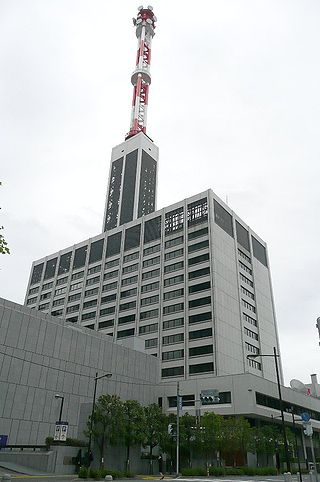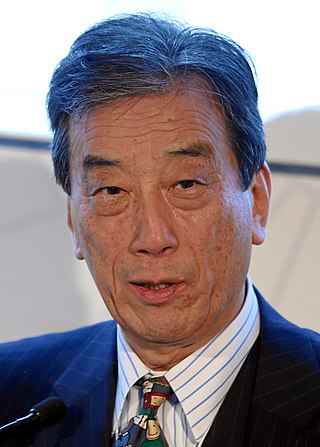
Tokyo Electric Power Company Holdings, Incorporated, also known as Toden or TEPCO, is a Japanese electric utility holding company servicing Japan's Kantō region, Yamanashi Prefecture, and the eastern portion of Shizuoka Prefecture. This area includes Tokyo. Its headquarters are located in Uchisaiwaicho, Chiyoda, Tokyo, and international branch offices exist in Washington, D.C., and London. It is a founding member of strategic consortiums related to energy innovation and research; such as JINED, INCJ and MAI.

The International Nuclear and Radiological Event Scale (INES) was introduced in 1990 by the International Atomic Energy Agency (IAEA) in order to enable prompt communication of safety significant information in case of nuclear accidents.

Nuclear safety in the United States is governed by federal regulations issued by the Nuclear Regulatory Commission (NRC). The NRC regulates all nuclear plants and materials in the United States except for nuclear plants and materials controlled by the U.S. government, as well those powering naval vessels.

The Fukushima Daiichi Nuclear Power Plant is a disabled nuclear power plant located on a 3.5-square-kilometre (860-acre) site in the towns of Ōkuma and Futaba in Fukushima Prefecture, Japan. The plant suffered major damage from the magnitude 9.0 earthquake and tsunami that hit Japan on March 11, 2011. The chain of events caused radiation leaks and permanently damaged several of its reactors, making them impossible to restart. The working reactors were not restarted after the events.

The Fukushima Daini Nuclear Power Plant is a nuclear power plant located on a 150 ha (370-acre) site in the town of Naraha and Tomioka in the Futaba District of Fukushima Prefecture, Japan. The Tokyo Electric Power Company (TEPCO) runs the plant.

On 11 March 2011, a nuclear accident occurred at the Fukushima Daiichi Nuclear Power Plant in Ōkuma, Fukushima, Japan. The proximate cause of the disaster was the Tōhoku earthquake and tsunami, which remains the most powerful earthquake ever recorded in Japan. The earthquake triggered a powerful tsunami, with 13- to 14-meter-high waves damaging the nuclear power plant's emergency diesel generators, leading to a loss of electric power. The result was the most severe nuclear accident since the Chernobyl disaster in 1986, classified as level seven on the International Nuclear Event Scale (INES) after initially being classified as level five, and thus joining Chernobyl as the only other accident to receive such classification. While the 1957 explosion at the Mayak facility was the second worst by radioactivity released, the INES ranks incidents by impact on population, so Chernobyl and Fukushima rank higher than the 10,000 evacuated from the Mayak site in the rural southern Urals.

Fukushima Daiichi is a multi-reactor nuclear power site in the Fukushima Prefecture of Japan. A nuclear disaster occurred there after a 9.0 magnitude earthquake and subsequent tsunami on 11 March 2011. The earthquake triggered a scram shut down of the three active reactors, and the ensuing tsunami crippled the site, stopped the backup diesel generators, and caused a station blackout. The subsequent lack of cooling led to explosions and meltdowns, with problems at three of the six reactors and in one of the six spent-fuel pools.

The Japanese reaction occurred after the Fukushima Daiichi nuclear disaster, following the 2011 Tōhoku earthquake and tsunami. A nuclear emergency was declared by the government of Japan on 11 March. Later Prime Minister Naoto Kan issued instructions that people within a 20 km (12 mi) zone around the Fukushima Daiichi nuclear plant must leave, and urged that those living between 20 km and 30 km from the site to stay indoors. The latter groups were also urged to evacuate on 25 March.
Radiation levels in Japan are continuously monitored in a number of locations, and a large number stream their data to the internet. Some of these locations are mandated by law for nuclear power plants and other nuclear facilities. Some of them serve as part of a national monitoring network for use in a nuclear emergency. Others are independent monitoring stations maintained by individuals.

Masao Yoshida was a nuclear engineer who served as plant manager of the Tokyo Electric Power Company Fukushima Daiichi Nuclear Power Plant during the Fukushima nuclear disaster.
The Fukushima disaster cleanup is an ongoing attempt to limit radioactive contamination from the three nuclear reactors involved in the Fukushima Daiichi nuclear disaster that followed the earthquake and tsunami on 11 March 2011. The affected reactors were adjacent to one another and accident management was made much more difficult because of the number of simultaneous hazards concentrated in a small area. Failure of emergency power following the tsunami resulted in loss of coolant from each reactor, hydrogen explosions damaging the reactor buildings, and water draining from open-air spent fuel pools. Plant workers were put in the position of trying to cope simultaneously with core meltdowns at three reactors and exposed fuel pools at three units.
The Investigation Committee on the Accident at the Fukushima Nuclear Power Stations of Tokyo Electric Power Company was formed June 7, 2011 by the Japanese government as an independent body to investigate the March Fukushima Daiichi nuclear disaster. The Investigation Committee issued an interim report in December 2011, and issued its final report in July 2012.

National Diet of Japan Fukushima Nuclear Accident Independent Investigation Commission or NAIIC is the commission to investigate the background and cause of Fukushima Daiichi nuclear disaster formed by the statutory law enactment by Diet of Japan on 7 October 2011 and started with the first commissioning meeting was held in Fukushima City, Fukushima Prefecture. The commission is scheduled to issue the report in six months on investigation and to propose the policy to reduce and prevent future accident and reduce damage on the nuclear power plant in Japan.

The Fukushima Daiichi nuclear disaster was a series of equipment failures, nuclear meltdowns, and releases of radioactive materials at the Fukushima I Nuclear Power Plant, following the Tōhoku earthquake and tsunami on 11 March 2011. It is the largest nuclear disaster since the Chernobyl disaster of 1986.

The Fukushima Daiichi nuclear disaster was a series of equipment failures, nuclear meltdowns, and releases of radioactive materials at the Fukushima I Nuclear Power Plant, following the Tōhoku earthquake and tsunami on 11 March 2011. It is the largest nuclear disaster since the Chernobyl disaster of 1986.

Unit 3 of the Fukushima Daiichi Nuclear Power Plant was one of the reactors in operation on 11 March 2011, when the plant was struck by the tsunami produced by the Tohoku earthquake. In the aftermath, the reactor experienced hydrogen gas explosions and suffered a partial meltdown, along with the other two reactors in operation at the time the tsunami struck, unit 1 and unit 2. Efforts to remove debris and coolant water contaminated with radiation are ongoing and expected to last several decades.

The Fukushima Daiichi nuclear accident was a series of equipment failures, nuclear meltdowns, and releases of radioactive materials at the Fukushima I Nuclear Power Plant, following the Tōhoku earthquake and tsunami on 11 March 2011. It was the largest nuclear disaster since the Chernobyl disaster of 1986, and the radiation released exceeded official safety guidelines. Despite this, there were no deaths caused by acute radiation syndrome. Given the uncertain health effects of low-dose radiation, cancer deaths cannot be ruled out. However, studies by the World Health Organisation and Tokyo University have shown that no discernible increase in the rate of cancer deaths is expected. Predicted future cancer deaths due to accumulated radiation exposures in the population living near Fukushima have ranged in the academic literature from none to hundreds.

Investigations into the Fukushima Daiichi Nuclear Disaster (or Accident) began on 11 March 2011 when a series of equipment failures, core melt and down, and releases of radioactive materials occurred at the Fukushima Daiichi Nuclear Power Station from the 2011 off the Pacific coast of Tohoku Earthquake and tsunami on the same day.

The Fukushima Daiichi nuclear disaster was a series of equipment failures, nuclear meltdowns, and releases of radioactive materials at the Fukushima I Nuclear Power Plant, following the Tōhoku earthquake and tsunami on 11 March 2011. It is the largest nuclear disaster since the Chernobyl disaster of 1986.

Fukushima 50 is a 2020 Japanese disaster drama film directed by Setsurō Wakamatsu and written by Yōichi Maekawa. Starring Koichi Sato and Ken Watanabe, it is about the titular group of employees tasked with handling the meltdown of the Fukushima Daiichi Nuclear Power Plant after the 2011 Tōhoku earthquake and tsunami. The film is based on the book by Ryusho Kadota, titled On the Brink: The Inside Story of Fukushima Daiichi, and it is the first Japanese film to depict the disaster.










